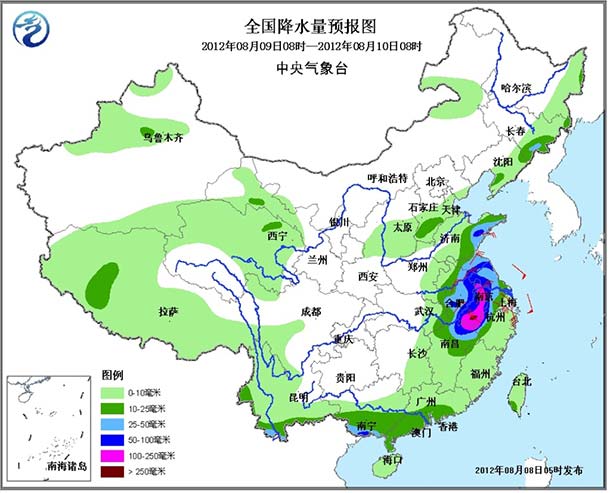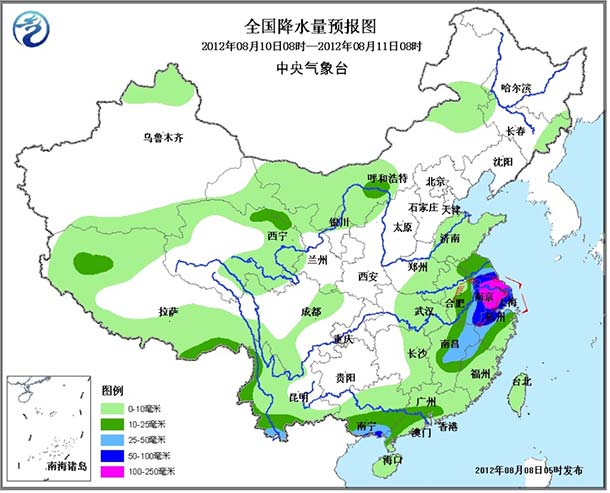There are strong precipitations in parts of Jiangsu, Anhui, Shanghai and other places.
There is moderate to heavy rain in North China in Northeast China.
First, important weather
1. There are strong precipitations in parts of Jiangsu, Anhui, Shanghai and other places.
The center of the No. 11 strong typhoon "Anemone" was landed at the coast of Hepu Town, Xiangshan County, Zhejiang Province at 0:20 on the 8th. The maximum wind force near the center at the time of landing was 14 (42 m/s). At 0400 on the 8th, “Anemone†weakened into a typhoon in Xiangshan County. At 0500, its center was located in Sanmen Bay, Xiangshan County, Zhejiang Province. The maximum wind force near the center was 13 (40 m/s).
It is estimated that "Anemone" will move to the northwest at a speed of about 15 kilometers per hour, and pass through the northern part of Zhejiang Province during the day on the 8th. It will enter the southeastern part of Anhui Province on the night of the 8th, and the intensity will gradually weaken.
Affected by it, from 8th to 10th, there were heavy rains in central and southern Jiangsu, central and southern Anhui, Shanghai, most of Zhejiang, northeastern Jiangxi, and southern Shandong. Among them, north central Zhejiang, southern Jiangsu, southern Anhui, There are heavy rains in the west of Shanghai and northeastern Jiangxi, and heavy rains (250-400 mm); there will be 9-11 winds in the north-central coastal areas of Zhejiang, Hangzhou Bay and the Yangtze River estuary, and the winds in some seas can reach 12-13, East China Sea. There will be a strong wind of 7-9 in the coastal areas of Shanghai, the southeastern coast of Jiangsu, the southern coast of Zhejiang, the northeastern coast of Fujian, the northern part of the Taiwan Strait, and the northern coast of Taiwan. There will be 7-8 winds in the east of Taiwan.
2. There is moderate to heavy rain in North China in Northeast China.
From the 8th to the 9th, there were moderate rains in parts of central and southern North China and most of the northeastern region. The local area was heavy rainstorms, accompanied by strong convective weather such as short-term thunderstorms and strong winds.
Second, the specific forecast for the next three days
From 08:00 to 8:00 on the 8th, there were heavy rains in most parts of Zhejiang, Shanghai, south-central Jiangsu, central and southern Anhui, and northeastern Jiangxi. Among them, north-central Zhejiang, southwestern Shanghai, southeastern Anhui, southern Jiangsu In some areas, there were heavy rains and heavy rains (250-400 mm); in addition, heavy rains occurred in parts of central Heilongjiang, western and northeastern Hebei, most of Tianjin, southern Yunnan, and southwestern Guangxi; Some areas are accompanied by strong convective weather such as short-term thunderstorms and strong winds. In the southern part of the Yellow Sea, there will be 7-8 grades of easterly winds. Most of the East China Sea will have 8-10 winds and gusts 11-13, and the Taiwan Strait will have 6-9 winds. 
From 08:00 to 10:00 on the 9th, there were heavy rains in the northeastern part of Jiangxi, northwestern Zhejiang, central and southern Anhui, most of Jiangsu, and southern Shandong. Among them, northeastern Jiangxi, northwestern Zhejiang, southern Anhui, southwestern Jiangsu There are heavy rains in some areas, and there are heavy rains (250-300 mm) in the local area. In addition, there are moderate to heavy rains in the eastern part of Northeast China, western and southern Yunnan, central and southern Guangxi, and southern Guangdong. Local rainstorms (50-80 mm) ); some of the above areas are accompanied by strong convective weather such as short-term thunderstorms and strong winds. There are 6-8 winds in most of Jiangsu, Shanghai, northern Zhejiang and coastal areas, and central and southern Anhui. The southern part of the Yellow Sea and most of the East China Sea will have 6-8 winds and 9 winds. 
From 08:00 on the 10th to 08:00 on the 11th, there were heavy rains in the northeastern part of Jiangxi, western and northern Zhejiang, Shanghai, south-central Jiangsu, and southeastern Anhui. Among them, some parts of northwestern Zhejiang, western Shanghai, southern Jiangsu, etc. Heavy rain (100-200 mm); in addition, there are moderate to heavy rains in the southeastern part of Tibet, western and southern Yunnan, southwestern Guangxi, and central and western Guangdong, with local heavy rain (50-70 mm); some of these areas are accompanied by thunderstorms and strong winds. Convective weather. There are 6-8 winds in central and southern Jiangsu, northern Zhejiang and coastal areas, and central and southern Anhui. 
There are two principal neodymium magnet manufacturing methods:
ï‚·Classical powder metallurgy or sintered magnet process
ï‚·Rapid solidification or bonded magnet process
Bonded NdFeB Magnet is made by evenly mixing neodymium iron boron powder with resin, plastics and low melting point metal and so oncaking agents, then made the boron permanent magnet of compound neodymium iron by methods such as compressing, pushing or injecting shaping. The products take shape once, do not need processing again and can be made into various complicated forms derectly. All directions of the Bonded Ndfeb Magnet are magnetic, and can be processed into compression moulds and injetion moulds.
Bonded Ndfeb Magnets are prepared by melt spinning a thin ribbon of the NdFeB alloy. The ribbon contains randomly oriented Nd2Fe14B nano-scale grains. This ribbon is then pulverized into particles, mixed with a polymer, and either compression- or injection-molded into bonded magnets. Bonded magnets offer less flux intensity than sintered magnets, but can be net-shape formed into intricately shaped parts, as is typical with Halbach arrays or arcs, trapezoids and other shapes and assemblies (e.g. Pot Magnets, Separator Grids, etc.). There are approximately 5,500 tons of Neo bonded magnets produced each year. In addition, it is possible to hot-press the melt spun nanocrystalline particles into fully dense isotropic magnets, and then upset-forge or back-extrude these into high-energy anisotropic magnets.
Bonded magnets can be made from either hard ferrite materials or rare earth magnetic powder. They are manufactured using both injection molding and compression bonding techniques which are fully automated and are particularly suitable for high volume production.
Bonded neo powder is incorporated into numerous end market applications that utilize bonded neo magnets. These products are primarily motors and sensors used in a range of products, including computer and office equipment (e.g., hard disk drives and optical disk drive motors and fax, copier and printer stepper motors), consumer electronics (e.g., personal video recorders and mp3 music players), automotive and industrial applications (e.g., instrument panel motors, seat motors andair bag sensors) and home ventilation systems (e.g., ceiling fans).
Application of Bonded Neodymium magnets:
•Magnetic separators
•Microphone assemblies
•Servo motors
•DC motors (automotive starters) and other motors
•Meters
•Odometer
•Sensors
Bonded Ndfeb Magnet
Bonded Ndfeb Magnet,Permanent Bonded Ndfeb Magnet,Compression Bonded Ndfeb Magnets,Bonded Ndfeb Magnets
Jinyu Magnet (Ningbo) Co., Ltd. , http://www.magnetbonwin.com